
|
|
The Model QH-50D
| |||||||||||||||||||||||||||||||||||||||||||||||||||||||||||||||||||||||||||||||||||||||||||||||||||||||||||||||||||||||||||||||||||||||||||||||||||||||||||||||||||||||||||||||||||||||||||||||||||||||||||||||||||||||||||||||||||||||||||||||||||||||||||||||||||||||||||||||||||||||||||||||||||||||||
Higher horsepower Boeing Free Turbine engine, model T50-BO-12, which added additional 65 shp. | |
BO-12 engine also was 84 lbs lighter than the C model's BO-8A (Boeing model 502-10VC). | |
Lighter weight Fiberglass rotor blades replaced wooden blades; increasing payload by 52 lbs. | |
Rotor blades given de-icing capabilities (internal heater mat) and all-weather capability. | |
Improved flotation package. | |
Aft Tail assembly of the C model deleted on the D model; increased payload by 100 lbs (P/N Y63-315460-1 and -16) | |
Increased basic fuel capacity from 35 to 52 gals. | |
The relocation of sensors (gyros and altitude control) to fuselage support housing. | |
The weapon mounting lug area of the fuselage support housing was redesigned to accommodate a "special weapon". | |
A clear approach was made for the Weaponmobile to the aft end of the drone therefore greatly increasing ease of weapon loading. | |
The transmission oil capacity was increased and the oil pump design was changed to make it an integral unit allowing it to be removed for bench testing. |
Taking advantage of the increased payload
capabilities of the D model,
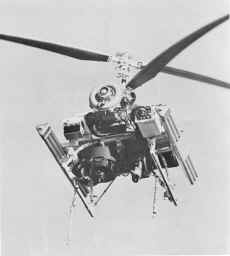
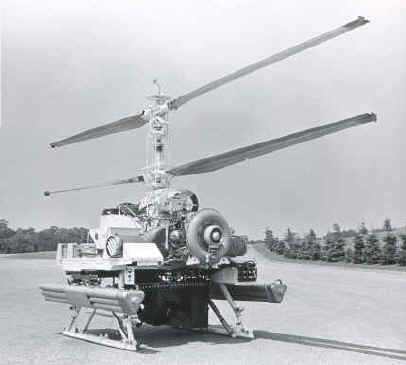 ARPA
had numerous programs in which they extensively "weaponized" the QH-50D. ARPA program "Nite Gazelle"
made the QH-50D at left an anti-personnel weapons platform by
the installation of two XM-18 Bomblet dispensers and two
M5 Turrets- one turret carried an XM129 Grenade Launcher
and the other a high resolution TV camera. Both turrets were slaved together so
the drone controller could track what he was shooting at.
Each Bomblet dispenser consisted of six tubes; each tube held 19 bomblets.
ARPA
had numerous programs in which they extensively "weaponized" the QH-50D. ARPA program "Nite Gazelle"
made the QH-50D at left an anti-personnel weapons platform by
the installation of two XM-18 Bomblet dispensers and two
M5 Turrets- one turret carried an XM129 Grenade Launcher
and the other a high resolution TV camera. Both turrets were slaved together so
the drone controller could track what he was shooting at.
Each Bomblet dispenser consisted of six tubes; each tube held 19 bomblets.
On the right, two separate
programs that were merge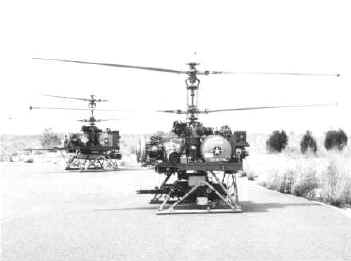 d
together further illustrates ARPA's weaponization of the QH-50D; program ATTACK
DRONE and GUN SHIP:
d
together further illustrates ARPA's weaponization of the QH-50D; program ATTACK
DRONE and GUN SHIP:
1. U.S. Navy QH-50D ATTACK DRONE program, s/n DS-1685 (background-right) is equipped with a telemetry package, Cohu real-time-down linked TV Camera mounted on a calibrated tilt mount with an ordnance load of two MK-81 bombs (250 lbs each).
2. U.S. Navy QH-50D GUN SHIP program, s/n
DS-1679 (foreground-right) is equipped with a daylight Cohu TV Camera that is bore
sighted to the calibrated tilt mounted General Electric GAU-2B-A Minigun.
The camera is used for target acquisition, aiming and damage evaluation.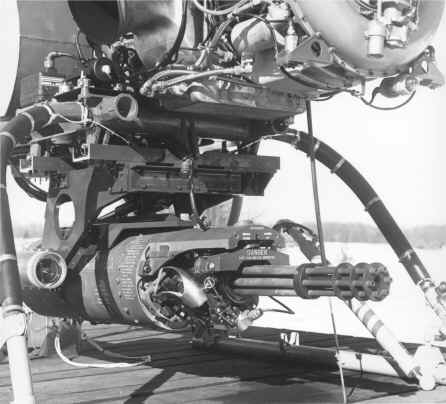 A close up of the General Electric GAU-2B-A Minigun, is seen at
left.
A close up of the General Electric GAU-2B-A Minigun, is seen at
left.
![]()
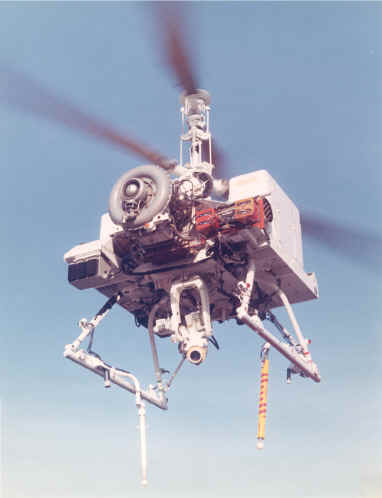 Reconnaissance, Surveillance
and Target acquisition (RSTA) had actually been the QH-50D's first foray into a
non-ASW application. Simply equipped with a real-time TV camera and flying from
the same destroyer platforms it used for its ASW role, NAVY program SNOOPY,
started in January 1965. The SNOOPY program had a simple goal: Give the
Destroyer Commander an "over-the-horizon situational awareness" in
order to more accurately target the Destroyer's 5" guns and provide
immediate gunnery correction. Soon however, the QH-50D was providing gunnery
data for the battleship, USS New Jersey.
Reconnaissance, Surveillance
and Target acquisition (RSTA) had actually been the QH-50D's first foray into a
non-ASW application. Simply equipped with a real-time TV camera and flying from
the same destroyer platforms it used for its ASW role, NAVY program SNOOPY,
started in January 1965. The SNOOPY program had a simple goal: Give the
Destroyer Commander an "over-the-horizon situational awareness" in
order to more accurately target the Destroyer's 5" guns and provide
immediate gunnery correction. Soon however, the QH-50D was providing gunnery
data for the battleship, USS New Jersey.
ARPA Program NITE PANTHER sought to expand SNOOPY by providing not only real-time TV down-link, but 3 hour loiter capability with a 50 mile operating range from the launching destroyer: Navy QH-50D, S/N DS-1735 (seen left), equipped with 3 separate fuel tanks for long range, aims its low light video camera at the photographer. The aircraft’s range could have been much greater, but the range was limited due to the tracking radar in use in the 1970’s by the launching Destroyers which used radar to track the Vehicle to and from its target.
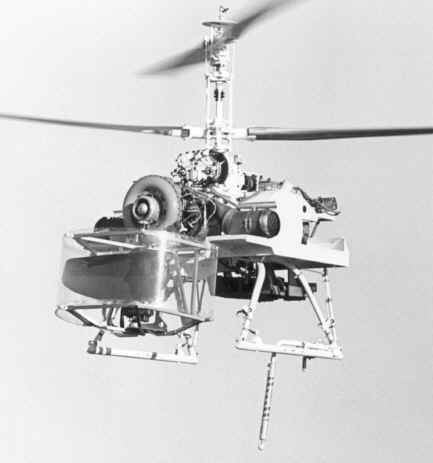
While ARPA and the Navy discovered that using the QH-50D as a multi-weapons platform was an easy extension of its ASW role, the idea of using the QH-50D as a Target Acquisition vehicle in "enemy active" regions was a novel use of its unmanned aircraft nature and allowed for "high threat environment" missions without the concern for possible loss of the pilot.
As seen at left, is a ARPA program, Nite Gazelle QH-50D equipped with an MTI AN/PPS-5 Radar System. With the system being attached with a Two-Axis tracking mount, this QH-50D transmitted its Airborne Warning Radar information through the telemetry system to ground display for target identification. In this use, the UAV provided over-the-horizon, real-time radar coverage for the launching destroyer. In this role, the QH-50D became the first and ONLY UAV to be ever used in a AWACS application!
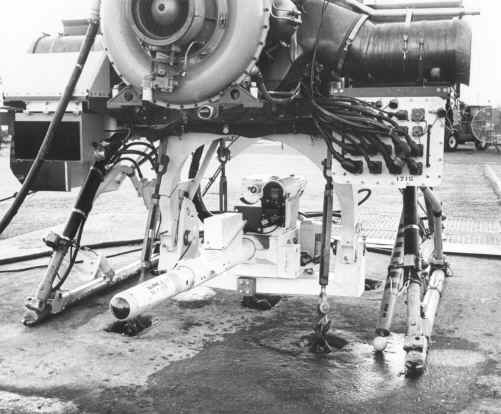 Given the success of the SNOOPY,
Nite Panther and Nite Gazelle QH-50D programs, the question of being
able
to more effectively destroy a target, after enemy target identification and
classification had occurred. ARPA responded with an extension of Nite Gazelle in
which a Laser designator was utilized:
Given the success of the SNOOPY,
Nite Panther and Nite Gazelle QH-50D programs, the question of being
able
to more effectively destroy a target, after enemy target identification and
classification had occurred. ARPA responded with an extension of Nite Gazelle in
which a Laser designator was utilized:
QH-50D, s/n DS-1715 (seen left), was a target
designator intended to provide illuminated targets for waiting fixed-wing
fighter-bomber aircraft . DS-1715 would use its day or night TV camera to locate
the target for the off-shore controller. Then upon authentication of the enemy
target, the laser unit would be activated into designating the target allowing
for waiting fighter-bombers to drop laser-guided munitions using the QH-50’s
laser beam for tracking to the target. The Laser/Camera unit was placed on a
tracking mount. Later, this QH-50D was armed with the LARS rocket system so that
it could also fire at its own acquired targets.
Derivatives of Uses for the QH-50D DASH VTOL-UAV |
||
| Project Name | Sponsor | Description |
| DESJEZ | U.S. Navy | Sonobuoy Dispensing, ASW Detection and Target destruction. Program was to also show defense of aircraft carriers from ship to ship missiles by acting as a decoy. |
| SNOOPY | U.S. Navy | Surveillance with real-time TV for Gun spotting for U.S. Surface Ships off Vietnam |
| MIDGET | U.S. Navy | Evacuation or Rescue (personnel) |
| DAMPS | U.S. Navy-Dam Neck Facility | Electronic Countermeasures |
| SEEK LAUNCHER | ARPA/U.S. Air Force | Surveillance- Base Perimeter Defense using MTI radar and low-light TV |
| BLOW LOW | DIA / ARPA / U.S. Navy | Surveillance (Day or Night) Sensor payload-classified |
| ARMY ARMED DRONE | ARPA / U.S. Army | Ordnance Delivery / TV Surveillance (used XM-129 Grenade Launcher and XM-25 Bomblet dispensers) |
| NITE PANTHER | ARPA | Surveillance and Artillery Spotting by the use of Radar. day and night TV, and other sensors with tracking capability for moving targets. |
| NITE GAZELLE | ARPA | Nite Panther with Ordnance delivery (precision bombing, SAWS Ammo, rockets and missiles) capability on stationary and moving targets: |
| GRANDVIEW | ARPA | Nite Gazelle operating through a Relay Data Link to extended ranges |
| CARGO | GYRODYNE | Vertical replenishment at Sea (VERTREP) and to high risk areas |
| SMOKE LAYING | GYRODYNE | Laying of Smoke to provide protective screening |
| MASSTER | ARPA / U.S. ARMY | Validation testing for Unmanned Aerial Surveillance System concept at Ft. Hood Texas; MTI radar and Low light TV as sensors. |
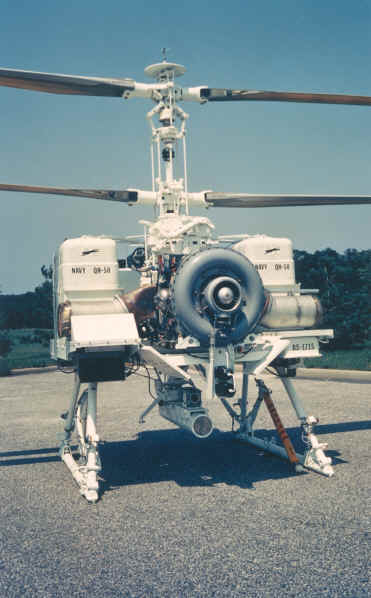 Although great strides were
made using the multi-platform capabilities of the QH-50D UAV in its use as a
weapons delivery and RSTA platform, DARPA ceased using the aircraft in 1974 due
to the draw down
in defense expenditures associated with the end of the Vietnam war. With the
DASH program having been officially cancelled in November 1970, further
strategic and tactical use for the QH-50D ended and the remaining 388 QH-50C and
D model drones were transferred to Naval Air Warfare Center-China Lake and U.S.
Army's PEO STRI - White Sands Missile Range. There, the unmanned air vehicle
that was developed to extend a pilots reach without increasing his risk, was unceremoniously
used as a "Target" for "real-kill" missile and
anti-helicopter development; over
350 aircraft were simply blown out of the sky before the military began to
rethink this policy.
Although great strides were
made using the multi-platform capabilities of the QH-50D UAV in its use as a
weapons delivery and RSTA platform, DARPA ceased using the aircraft in 1974 due
to the draw down
in defense expenditures associated with the end of the Vietnam war. With the
DASH program having been officially cancelled in November 1970, further
strategic and tactical use for the QH-50D ended and the remaining 388 QH-50C and
D model drones were transferred to Naval Air Warfare Center-China Lake and U.S.
Army's PEO STRI - White Sands Missile Range. There, the unmanned air vehicle
that was developed to extend a pilots reach without increasing his risk, was unceremoniously
used as a "Target" for "real-kill" missile and
anti-helicopter development; over
350 aircraft were simply blown out of the sky before the military began to
rethink this policy.
In 1986, The U.S. Navy was running out of QH-50s at an alarming rate because missiles were becoming much better. Believing that the 1965 fly-away cost of $154,000 per aircraft had remained the same, the Navy issued an RFQ for 21 QH-50D drones to be built by Gyrodyne and was stunned to learn that the 1986 cost, using a modern Allison 250-C20S engine (Boeing ceased their engine manufacturing in April 1968 to devote all their resources to the new 747 airliner program) was approximately $ 2.2 million per aircraft. The Navy then began having their existing aircraft "tow" targets to prevent the QH-50s from being shot down and this target-towing continued long after NAWC-China Lake lost their QH-50 program and aircraft to U.S. Army's Program Executive Office for Simulation, Training, and Instrumentation (PEO-STRI) in 1995.
![]()
Today, there about 26 QH-50D UAVs that are
still in use at U.S. ARMY
PEO-STRI's TMO.
Gyrodyne Helicopter Historical Foundation is the only civilian entity that owns
one
(see our museum supported page to see it at the
Hawthorne Ordnance Museum).
PERFORMANCE SUMMARY- QH-50D |
||||||||||||||||||||||||||||||||||||||||||||||||||||||||||||||||||||||||||||||||||||||||||||||||||||||||||||||||||||||||||||||||||||||||||||||
|
Take-Off Loading Conditions- Full Reg. Fuel (no aux fuel) |
||||||||||||||||||||||||||||||||||||||||||||||||||||||||||||||||||||||||||||||||||||||||||||||||||||||||||||||||||||||||||||||||||||||||||||||
First Flight of QH-50D was on April 9, 1965 |
||||||||||||||||||||||||||||||||||||||||||||||||||||||||||||||||||||||||||||||||||||||||||||||||||||||||||||||||||||||||||||||||||||||||||||||
| TAKE-OFF WEIGHT | 2550 LBS. |
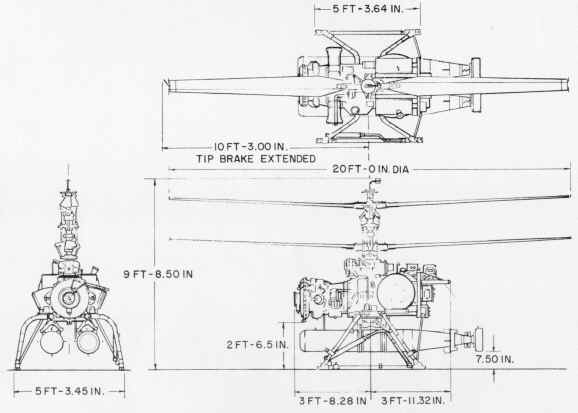
|
||||||||||||||||||||||||||||||||||||||||||||||||||||||||||||||||||||||||||||||||||||||||||||||||||||||||||||||||||||||||||||||||||||||||||||
| Fuel & Oil weight | 375 LBS. | |||||||||||||||||||||||||||||||||||||||||||||||||||||||||||||||||||||||||||||||||||||||||||||||||||||||||||||||||||||||||||||||||||||||||||||
| Empty weight | 1035 LBS. | |||||||||||||||||||||||||||||||||||||||||||||||||||||||||||||||||||||||||||||||||||||||||||||||||||||||||||||||||||||||||||||||||||||||||||||
| Payload (regular) |
920 LBS. | |||||||||||||||||||||||||||||||||||||||||||||||||||||||||||||||||||||||||||||||||||||||||||||||||||||||||||||||||||||||||||||||||||||||||||||
| Payload (overload) |
1140 LBS. | |||||||||||||||||||||||||||||||||||||||||||||||||||||||||||||||||||||||||||||||||||||||||||||||||||||||||||||||||||||||||||||||||||||||||||||
| MAX Rotor RPM | 610 | |||||||||||||||||||||||||||||||||||||||||||||||||||||||||||||||||||||||||||||||||||||||||||||||||||||||||||||||||||||||||||||||||||||||||||||
| Ceiling: Service | 16,000 ft. | |||||||||||||||||||||||||||||||||||||||||||||||||||||||||||||||||||||||||||||||||||||||||||||||||||||||||||||||||||||||||||||||||||||||||||||
| Hover: (OGE) | 6500 ft. | |||||||||||||||||||||||||||||||||||||||||||||||||||||||||||||||||||||||||||||||||||||||||||||||||||||||||||||||||||||||||||||||||||||||||||||
| Hover: (IGE) | 11,500 ft | |||||||||||||||||||||||||||||||||||||||||||||||||||||||||||||||||||||||||||||||||||||||||||||||||||||||||||||||||||||||||||||||||||||||||||||
| Vertical Rate of Climb at Sea Level | 1180 fpm | |||||||||||||||||||||||||||||||||||||||||||||||||||||||||||||||||||||||||||||||||||||||||||||||||||||||||||||||||||||||||||||||||||||||||||||
| Maximum rate of climb at Sea Level | 1880 fpm | |||||||||||||||||||||||||||||||||||||||||||||||||||||||||||||||||||||||||||||||||||||||||||||||||||||||||||||||||||||||||||||||||||||||||||||
| Max. Speed/alt. | 80 knots/S.L. | |||||||||||||||||||||||||||||||||||||||||||||||||||||||||||||||||||||||||||||||||||||||||||||||||||||||||||||||||||||||||||||||||||||||||||||
|
|
||
|
QH-50D Drone General Assembly Diagram |
||
| 1. Tip Brakes | 7. Airborne Generator | 13. Antenna |
| 2. Upper rotor assembly | 8. Transmission housing | 14. MK-44 Homing Torpedo |
| 3. Static pressure pick-up | 9. Fuselage frame and transmission support housing |
15. Engine |
| 4. Rotating controls | 10. AFC set components | 16. Servo actuator |
| 5. Lower rotor assembly | 11. Fuel Tank | 17. Non-rotating controls |
|
6. Bell Housing |
12. Landing Gear | |
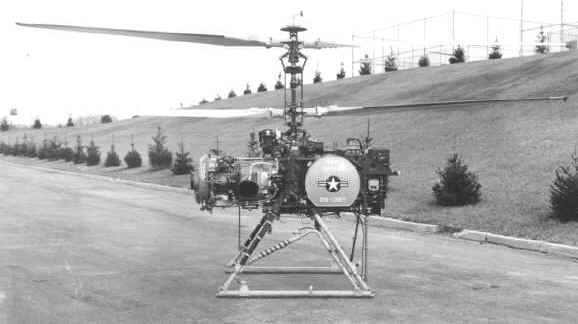
Serial Number HistoryQH-50D Drone |
|||
Serial Numbers |
Number Produced |
Manufacture Date |
Disposition |
| DS-1382 (seen above) | 1 | January 2, 1966 | Built under contract NOw 64(A)-0158-i, DS-1382 was converted from a C model to a D after three other C models had been converted and tested as YQH-50D's. |
| DS-1383 through DS-1385 | 3 |
January 2 to 20, 1966 |
Upon acceptance of DS-1382, the other converted QH-50C's that had been converted into D's lost the YQH-50D designation and were accepted by the Navy as well. |
| DS-1386 through DS-1572 | 186 |
January 20, 1966 through July 1967 |
The initial batch of original QH-50Ds, these aircraft were quickly deployed to the fleet so that the less reliable C models could be retired and stored. Because of this swapping, the C models became available at stateside for weapons developments and were used as targets by NAWC-China Lake sooner. This is why so few C models remain today, other than in museums. |
| JMSDF Aircraft J-1 through J-16 | 16 |
November 1966 through January 1967 |
As a follow-on production to the 3 QH-50C's and single QH-50D provided by the U.S. Navy, The Japanese Maritime Self-Defense Force (JMSDF) ordered 16 additional aircraft for their DASH program. During the program, which ended in 1976, the Japanese attained a MTBF of over 500 hrs. During the program they lost only three reported aircraft. What happened to the remaining QH-50Ds is not known. |
| DS-1573 through DS-1758 | 187 |
July 1967 through August 29, 1969 |
DS-1758 marked the end of "Official" Navy production. DS-1758 did not survive having been used as a aerial target by the Navy, but DS-1757 did (second to last) and is awaiting disposition at White Sands Missile Range-U.S. Army PEO-STRI's TMO. |
| PJP-1 through PJP-2 | 2 |
September 1 through 7, 1969 |
Manufactured before the assembly line was shut down, these two aircraft were ordered by the President of Gyrodyne, Mr. Peter James Papadakos. Mr. Papadakos felt that these two aircraft would be needed in the future and they were- 18 years later, in 1987 they were shipped to Germany where the Dornier company used them to demonstrate a new way to use the QH-50 Helicopter. They both are currently still in Germany. |
![]()
![]()
|
The name "Gyrodyne" in its stylized
form above, is the Trademark of and owned by the Gyrodyne Helicopter Historical
Foundation; unauthorized use is PROHIBITED by Federal Law. All Photographs, technical specifications, and
content are herein copyrighted and owned exclusively by Gyrodyne Helicopter
Historical Foundation, unless otherwise stated. All Rights Reserved
©2013. |